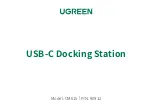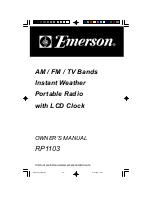
Adjusting the Rain Collector II
6
6. Open the SIM housing on the ISS. Remove
the foam insert and feed the rain collector
cable up through the opening. Plug the cable
to the appropriate connector. Replace the
foam and close the SIM housing.
Sensor
Interface
Module
(SIM)
Foam
Insert
7. To be certain the rain collector is functioning properly after installation, retest the unit
See “Test the Rain Collector II” on page
8. Place the cone back onto the base by putting the latches on the cone into the latch
openings in the base and rotating the cone clockwise until the latches “lock” into
place. As you reattach the cone, make sure to run the cable to the cable slot in the base,
or the cone will not fit snugly against the base.
9. Place the debris screen, points down, into the cone. The screen prevents large bits of
debris from blocking the funnel hole.
10.To prevent fraying or cutting of the cable where it is exposed to weather, it is impor-
tant that you secure it so it doesn’t whip about in the wind.
Use cable clips or weather resistant cable ties to secure the cable. Place clips or ties
approximately every 3 to 5 feet (1
to
1.6
m). Do not use metal staples or a staple gun
to secure cables. Metal staples—especially when installed with a staple gun—have a
tendency to cut the cables.
Extending Cable Runs
If the cable length supplied with the rain collector is not long enough for your purposes,
you may extend it. The maximum length of cable is 900 feet (274 m). To extend the
cable, purchase standard 4-Conductor Extension Cables from Davis and connect them to
the existing rain collector cable.
Adjustment Guide
Adjusting the Rain Collector II
The Rain Collector II (US version) is calibrated at the factory
so the bucket tips (and records rainfall) for each 0.01" (or 0.2
mm if the metric adapter has been fitted) of rain. To adjust the
calibration slightly, use a 3/16” (or 5 mm) wrench to rotate the
adjustment screws which are located underneath the bucket
(see “Rain Collector Internal Components” on page
2). The
adjustment guide embossed in the platform shows how far
you must rotate both screws in turn to effect a 1% and a 2%


























